Employee performance review (+templates)
To evaluate the performance of their employees, managers usually conduct performance appraisals. This way, team leads can:
- Review employee strengths and weaknesses,
- Review employee skills and abilities, and
- Provide suggestions for work improvements.
In this guide, we’ll explain what performance reviews are, their types, and the significance they have in the workplace.
We’ll also go through some practical tips for writing such appraisals, along with the exact steps you should take when reviewing someone’s work.
Finally, we’ll provide you with free employee performance review templates. These templates are suitable for online use, but you can also download or print them.
Download employee performance review templates
1. Monthly performance review template
GET Monthly performance review template (Google Docs)
GET Monthly performance review template (Word)
GET Monthly performance review template (PDF)
2. Quarterly performance review template
GET Quarterly performance review template (Google Docs)
GET Quarterly performance review template (Word)
GET Quarterly performance review template (PDF)
3. Mid-year performance review template
GET Mid-year performance review template (Google Docs)
GET Mid-year performance review template (Word)
GET Mid-year performance review template (PDF)
4. Annual performance review template
GET Annual performance review template (Google Docs)
GET Annual performance review template (Word)
GET Annual performance review template (PDF)
5. Peer review template
GET Peer review template (Google Docs)
GET Peer review template (Word)
GET Peer review template (PDF)
6. Self-assessment review template
GET Self-assessment review template (Google Docs)
What is a performance review?
A performance review (also known as a performance evaluation or a performance appraisal) is a written assessment that contains all the details about an employee's contributions at work over a given time period.
Managers conduct employee evaluations to review the performance of their employees regarding their:
- Strengths and weaknesses
- Skills and competencies
- Ability to meet deadlines
- Ability to work in a team
- Attendance history
Once managers have all the info about employees, they need to provide their workers with feedback. For example, if there are some particular areas for improvement, managers need to let employees know, so that corrections can be made.
Performance review: 6 common methods and self-evaluationsTypes of performance reviews
When evaluating the work of employees, reviewers can conduct appraisals by analyzing an individual performance over a specific period of time, such as a month or a longer time frame.
Speaking of a person performing an appraisal, this is usually a manager or a team lead, but can also be coworkers and employees themselves, in the case of peer reviews and self-assessments.
To show you the most common types of performance reviews, we will divide performance appraisals by the following parameters:
- Their frequency
- The person conducting the review
Let’s see what each of these categories entails.
Types of performance reviews by frequency
When it comes to the frequency of performance appraisals, we can distinguish between:
- Monthly performance reviews
- Quarterly performance reviews
- Mid-year performance reviews
- Annual performance reviews
There are also weekly or fortnightly performance appraisals — although they’re not as common as the types of reviews listed above.
Monthly performance reviews
Monthly performance reviews are especially practical when managers need to evaluate the work of:
- Newly hired employees — to review their performance during their first assignments.
- Employees working on a new project — to evaluate the work of all employees involved in a project.
- Employees on short-term contracts or freelancers — to review their work during the limited amounts of time during which they are employed.
Monthly performance reviews are a great way to make sure that workers stay on track with project progress and that their work is aligned with the company’s goals.
Quarterly performance reviews
When doing quarterly appraisals, managers focus on employee performance over three months of the year. And, since there are 12 months in a year, there are four quarters — four quarterly reviews (Q1, Q2, Q3, and Q4).
Each quarterly appraisal needs to include metrics such as:
- Goals
- Targets
- Budgets
Then, team leads can use these metrics to evaluate their employees.
In addition, they can also review employee performance by highlighting employees’ areas of excellence and areas that need improvement.
Mid-year performance reviews
Mid-year performance appraisals cover a six-month period and represent employee performance over these six months.
The key advantage of conducting mid-year reviews is that it gives managers a better overview of:
- Employee past performance (over the last six months) — the tasks and activities that worked well and those that haven’t, as well as the highlights of employee performance.
- Plans for the next six months — the precise methods that will help employees improve their critical areas. Managers can also see employee goals for the next six months along with a precise plan to achieve them.
Annual performance review
Annual performance appraisals are a great way to evaluate employee work over a year.
It’s a summary of all the achievements an employee has managed to accomplish over the past year, as well as suggested areas for improvement.
However, this type of review isn’t suitable for all businesses, because it isn’t always easy to sum up an entire year of work into one work performance review. So, instead of evaluating employees once a year, many companies opt for 360 Performance reviews — which we’ll explain in the next section.
Types of performance reviews by the reviewer
Now, when it comes to the person performing a review, it doesn’t always have to be a manager.
Here are some other types of reviews that don’t entirely (or at all) include team leads:
- 360 Performance review — managers and coworkers perform such appraisals
- Peer review — teammates evaluate other colleagues
- Self-assessment — employees review their own work
360 Performance review
360 Performance appraisals are reviews that gather information about employees from their managers and coworkers from their team.
Aside from employee performance, this type of evaluation focuses on reviewing areas such as:
- Accountability and work habits
- Trust and honesty
- Teamwork
- Interpersonal communication
- Leadership
A 360 Performance review is invaluable because it provides feedback about individual performance from all directions.
Peer review
Unlike with the 360 Performance review, in a Peer review, teammates are solely the ones who review employee performance.
Here are the key areas this review needs to cover:
- Ability to work in a team
- Ability to collaborate and communicate with other teammates
- Trust and respect
- Accountability
This type of feedback is important because it can reveal particular skills, or strengths and weaknesses that managers wouldn’t be able to figure out themselves. After all, it’s only logical that team members who are constantly collaborating will be able to understand and assess each others’ way of work from a different angle than managers.
Self-assessment review
A self-assessment review ensures that employees reflect on their performance over a set period of time.
When filling out a self-assessment review, employees should think of examples of good and poor performance.
Moreover, they also need to figure out what barriers stand in their way of achieving results, and find ways to overcome these barriers.
Finally, workers should think about the metrics they’ll use to measure their performance — and ensure that they’re on track.
Why are performance reviews important?
Here are the key reasons why job performance reviews are significant for both managers and employees.
Performance reviews ensure personal roles are linked with business goals
Performance appraisals are significant because they show whether individual roles are aligned with business vision and goals.
In simpler terms, it’s important that employees understand the bigger picture — i.e. how their role within the company affects the company's vision and goals.
For example, content writers need to understand that the blog posts they are writing are a vital part of the company’s marketing strategy, which further affects the overall success of a company. So, by creating quality content, content writers are helping increase the visibility of the company and driving more organic traffic to the company’s website, and are thus helping accomplish business goals in the long run.
And, it’s up to managers to make sure that all employees know what their responsibilities and roles are. That way, workers can give their best to accomplish overall targets.
And, when appraisals show that employee performance doesn’t contribute to the bigger picture, managers need to let employees know that.
When everyone’s on the same page when it comes to job roles and responsibilities, it’s easier both for employees and managers to perform better.
Performance reviews provide regular feedback about work
Providing employees with regular feedback will help them see what their strengths and weaknesses are. Performance appraisals are a great way to include feedback about someone’s work.
Besides, employees will know what is expected of them, so they’ll be able to act accordingly.
This also increases transparency within the organization and improves communication among employees and their managers.
Performance reviews help workers plan their career better
Performance reviews can help employees set precise objectives as a reference point in their career.
These objectives will allow employees to develop their skills and advance their career in the long run.
In addition, performance appraisals will reveal any areas that need improvement. Then, if needed, employees can request training from their mentors, to gain the ability to reach their set goals.
Free goal tracker appPerformance reviews ensure that employees are rewarded for good work
When employees work hard and achieve great results, this will be reflected in their performance appraisals.
In such cases, managers need to make sure to include attributes like “exceeds expectations” when describing employee performance.
As a result, seeing such appraisals will surely motivate employees to continue with the good work. Besides, they’ll know that all their efforts and long hours were worth it.
How to cope with working long hoursHow do you evaluate employees?
If you’re a manager, and you’re wondering how you should evaluate your employees, read on.
We’ll guide you through all the essential steps.
Step 1: Read employee job descriptions
The first step is reviewing job descriptions for each employee. That way, you’ll make sure you know the responsibilities of each team member.
Then, it’ll be easier for you to compare employee performance with these benchmarks.
Next, write down what employees generally do well and what areas need improvement.
Note down the examples that show when employees exceeded their expectations.
Step 2: Emphasize exceptional areas
The next step is to find out the areas where employees have significantly improved their performance. Try to be specific and use examples if you can.
In the case you have previous performance reviews for particular employees, make sure to compare them with the current appraisal.
Additionally, if some employees have completed a course, a training, or have earned certifications, be sure to include these details in your performance review.
Step 3: Evaluate strengths, weaknesses, opportunities, and threats
This step entails using previous appraisals to review employee strengths and weaknesses.
Then, think about how these traits have changed since the previous review.
You can use the SWOT framework for this step:
- S — strength
- W — weakness
- O — opportunities
- T — threat
Evaluating strengths
Consider all the strengths of each employee, such as accomplishments and their expertise.
For example, sales representatives need to make 20 sales each week. So, if some employees manage to make 30 sales per week, these sales reps are surely exceeding expectations by setting higher standards for themselves.
Thus, proactivity is their key strength.
Evaluating weaknesses
Think about an employee’s weaknesses as well, and include solutions to such issues, if you can.
For instance, if you think that some workers need to improve their communication skills, you can suggest having a meeting with this person and brainstorming possible solutions together. Or, an HR team can organize a communication training session for the entire team.
Evaluating opportunities
Next, find out how employees can use their positive attributes to excel — i.e. their opportunities.
For example, an employee is a quick learner and able to finish tasks on time. This shows managers that they can count on such workers when looking for someone to join a vital project.
Evaluating threats
Finally, note down possible threats that can happen along the way, so that employees can find a way to prevent them.
For example, if workers struggle with communicating their messages clearly, provide them with some practical tips on how to create transparent messages. That way, you’ll increase the chances to prevent any potential misunderstandings.
Step 4: Suggest actions that can improve employee performance
As their manager, you should empower your employees to enhance their performance, which will allow them to advance their career in the long run.
You can recommend particular goals that will be beneficial to your employees, along with ways to accomplish these targets. Just remember that these goals need to be aligned with the company's values and vision.
For instance, you can encourage your employees to set SMART goals:
- S — Specific
- M — Measurable
- A — Attainable
- R — Relevant
- T — Time-bound
This way, employees will find it easier to set goals for the future. Additionally, they will have a clearer picture of what their plans for improving performance should look like.
How to set SMART goals (+ examples and templates)Step 5: Provide employees with feedback
Always be sure to include constructive feedback in your performance reviews.
That means that even when employees have some areas that need to be improved, remember to give suggestions on how to improve such areas.
For example, what tactics they should use, or whether they should change the way that they perform particular tasks.
And, of course, when it comes to areas where employees excel, make sure to highlight these achievements, too.
Step 6: Encourage employee input
Finally, let your employees know that they have an opportunity to share their thoughts on employee reviews, too.
So, if there’s anything they didn’t quite understand, or they’d like to discuss with you, encourage them to do so.
It’s vital that employees feel included because, that way, they’ll be more motivated to perform better and accomplish the goals you’ve set out for them.
What do you write in an employee evaluation?
If you’re wondering how to write a performance review and what areas to include, we’ll now guide you through some vital steps.
Here are the most crucial areas employee evaluations should focus on:
- Achieving goals
- Leadership qualities
- Communication skills
- Teamwork
- Culture and values
Let’s explore each area in more detail. We’ll also provide you with the phrases you can use in your appraisals.
Achieving goals
You need to evaluate whether employees set challenging goals for themselves and how they deal with obstacles that prevent them from achieving these goals.
In addition, it’s important to review if employees help other coworkers accomplish their targets, too.
When it comes to the exact wording you can use for this area, here’s an idea from the book Effective Phrases for Performance Appraisals by James E. Neal:
"Achieves optimal levels of performance with/for…"
Additionally, when talking about improvement, you can use phrases like:
"Continues to grow and improve…"
and
"...is continuously planning for improvement…"
Leadership qualities
To review someone’s leadership skills, you need to consider whether employees take into accounts other people’s ideas when making decisions.
It’s also crucial to review if employees are willing to help each other with any work-related problems.
Speaking of the wording, here’s a suggestion from the book we previously mentioned:
"Provides support during periods of organizational change…"
Communication skills
Communication skills are essential in the workplace, which is why they need to be included in performance reviews.
You need to evaluate if employees communicate clearly and transparently with others and whether they listen actively.
You can use phrases included in the aforementioned book, like:
"Effectively communicates expectations…"
"Excels in facilitating group discussions…"
Teamwork
As their manager, you need to review if employees collaborate well with other team members.
Besides, it’s also important how they provide and receive feedback within the team.
Another thing to have in mind when evaluating teamwork skills is whether employees treat other coworkers with respect.
You can use phrases like:
“Effectively collaborates with other team members…”
“Actively participates in work-related discussions…”
Culture and values
It’s also important to think about company values and culture, and whether employees share the same values.
When employees respect the same values as the company does, it’ll be much easier for everyone to get along with each other.
You can include phrases such as:
“Promotes company values every day…”
“Nurtures a positive work environment…”
Employee performance review templates
To help you conduct performance appraisals easier, we created six free employee performance report templates:
- Monthly performance review template
- Quarterly performance review template
- Mid-year performance review template
- Annual performance review template
- Peer review template
- Self-assessment template
In case you want to share these templates with your colleagues, you can use the Google Docs version.
On the other hand, if you want to download the template, be sure to use the Word version.
Finally, if you prefer paper to online versions, you can use the printable, PDF version.
Monthly performance review template
GET Monthly performance review template (Google Docs)
GET Monthly performance review template (Word)
GET Monthly performance review template (PDF)
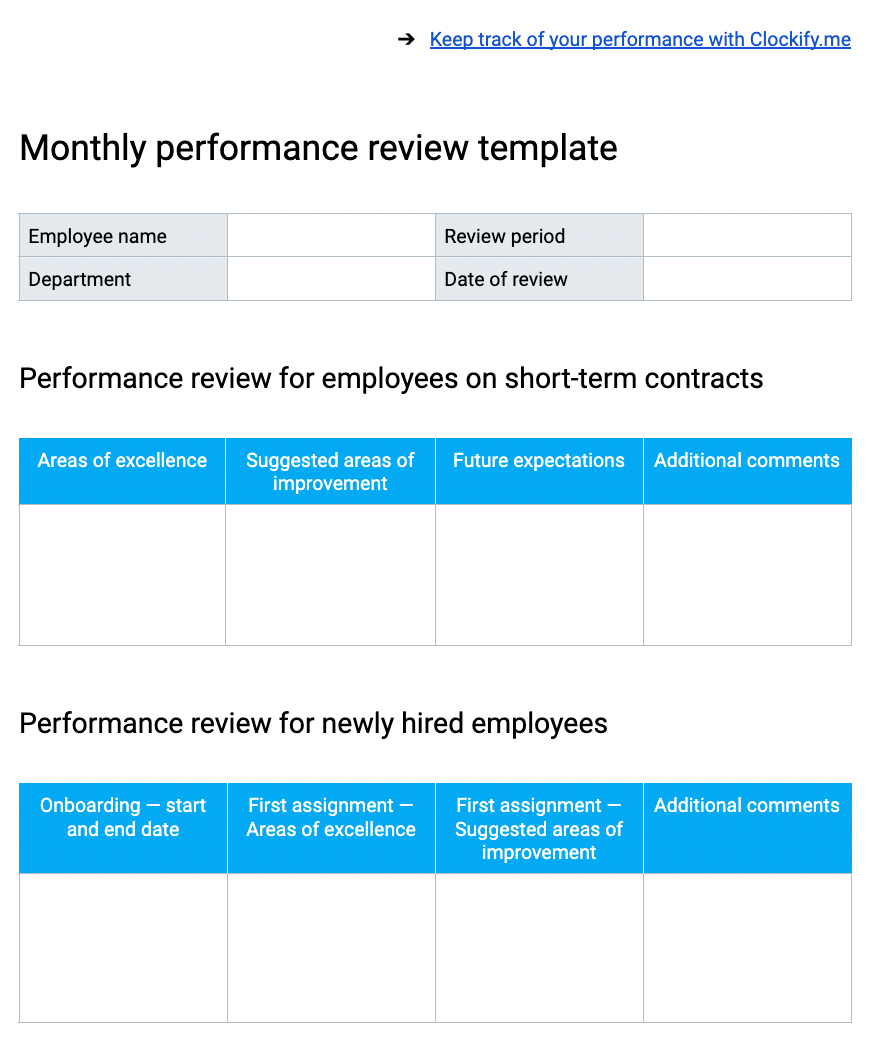
What's it about?
Our Monthly performance review template is quite practical because you can use it as a performance review:
- For employees on short-term contracts — you can review areas of excellence and areas that need improvement, as well as note down what employees should do in the near future.
- For newly hired employees — this is a perfect opportunity to review the work of employees from onboarding to the end of their first month. In addition, you can also review what they did well and what they need to work on in the future.
- For employees working on a new project — to ensure that everyone involved in a new project does their part according to the plan, you can review employee performance over the last month.
Depending on the type of employment you’d like to evaluate, simply choose the part of the template that’s suitable for you and your team.
Who is this template for?
In general, any managers who’d like to evaluate the work of their employees after the first month spent on a new project. Additionally, team leads who want to review the work of their employees on short-term contracts or the work of newly hired workers.
Quarterly performance review template
GET Quarterly performance review template (Google Docs)
GET Quarterly performance review template (Word)
GET Quarterly performance review template (PDF)
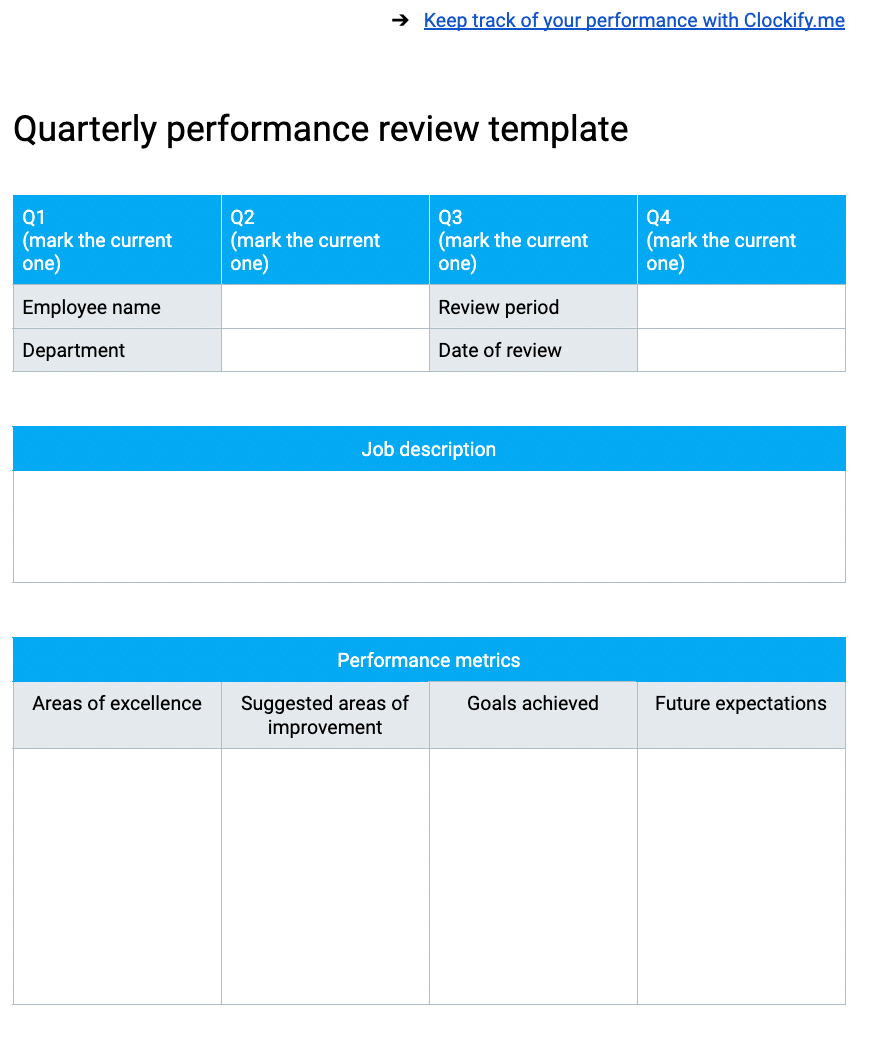
What's it about?
Our Quarterly performance review template allows you to reflect on the work of employees over the last three months.
To use this template properly, be sure to choose between Q1, Q2, Q3, and Q4.
Then, to remind yourself of the exact job description for each employee, you can add that details, too. After all, this is vital because a job description acts as a reference point for the quality of an employee’s overall performance.
Next, focus on performance metrics, such as areas of excellence and areas an employee needs to improve. Think about how workers performed over the last quarter in the following areas:
- What tasks they did well
- What tasks they could have done better
- What goals they have achieved
- What you expect them to do until the next quarterly performance review
Finally, this template includes a section where both reviewers and employees can add any additional comments.
Who is this template for?
Our Quarterly performance review template is suitable for managers who wish to perform employee appraisals several times a year. Therefore, they can use this template to evaluate the work of their employees over the three months.
What’s more important, team leads can figure out if employees improve their performance throughout the year — by comparing four quarterly appraisals.
Mid-year performance review template
GET Mid-year performance review template (Google Docs)
GET Mid-year performance review template (Word)
GET Mid-year performance review template (PDF)
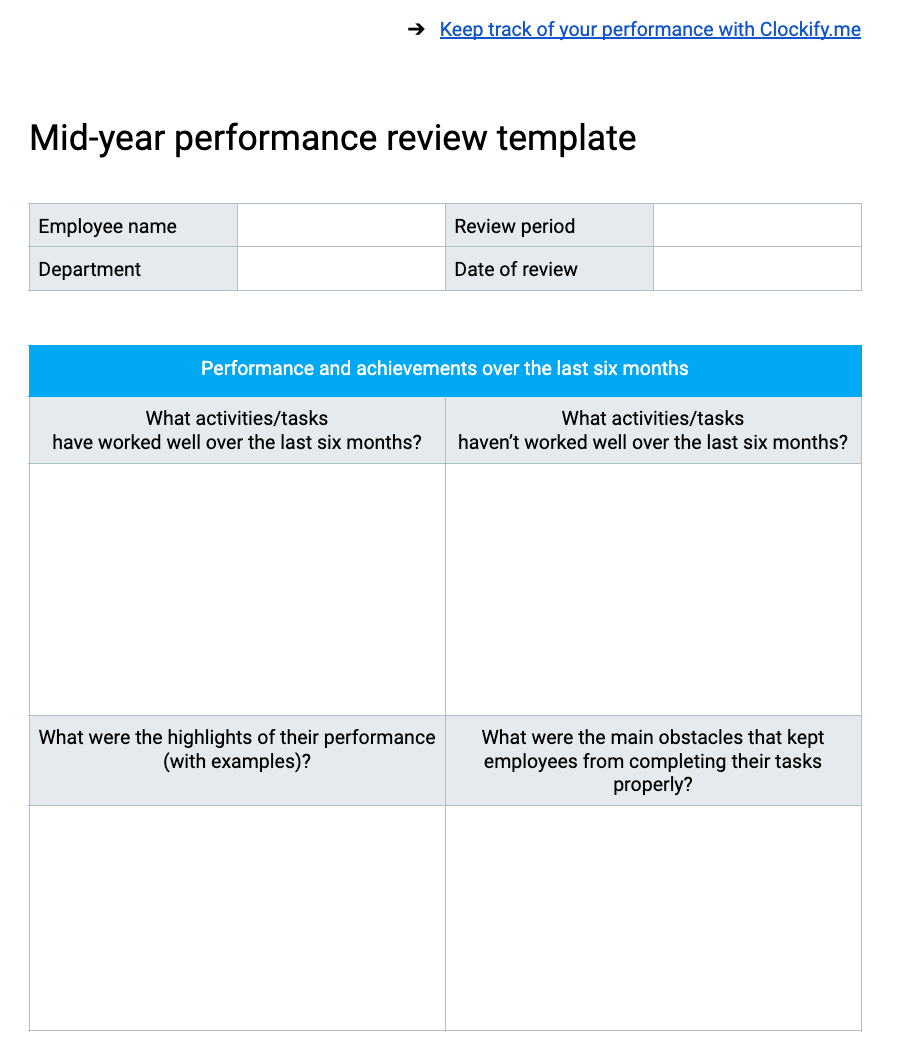
What's it about?
The Mid-year performance review template evaluates the work of employees over the last six months. But, this template also helps managers and employees plan for the next six months, too.
To make the most of this template, you should first think about how employees have performed since the last performance review:
- What activities or tasks went well
- What activities or tasks employees could have done better
In addition, be sure to include:
- The highlights of employee performance, along with examples
- The main obstacles that kept employees from achieving better results
If you don’t know exactly what these issues were, talk with your employees to find out more about their struggles. This way, it’ll be much easier to prevent such problems in the future.
Next, think about the six months ahead of you.
This is the part of the template you should fill out with your employees. So, discuss the following questions with them:
- Employee plans on improving their weak areas of performance, and whether they need any help.
- Employee professional goals for the next six months, along with how they plan on achieving them. Also, ask employees if these goals are aligned with team targets and the company's mission.
Who is this template for?
Our Mid-year performance review template is helpful for team leads who’d like to conduct appraisals twice a year. This way, managers will be able to keep an eye on employee performance throughout the year — by comparing mid-year reviews.
Annual performance review template
GET Annual performance review template (Google Docs)
GET Annual performance review template (Word)
GET Annual performance review template (PDF)
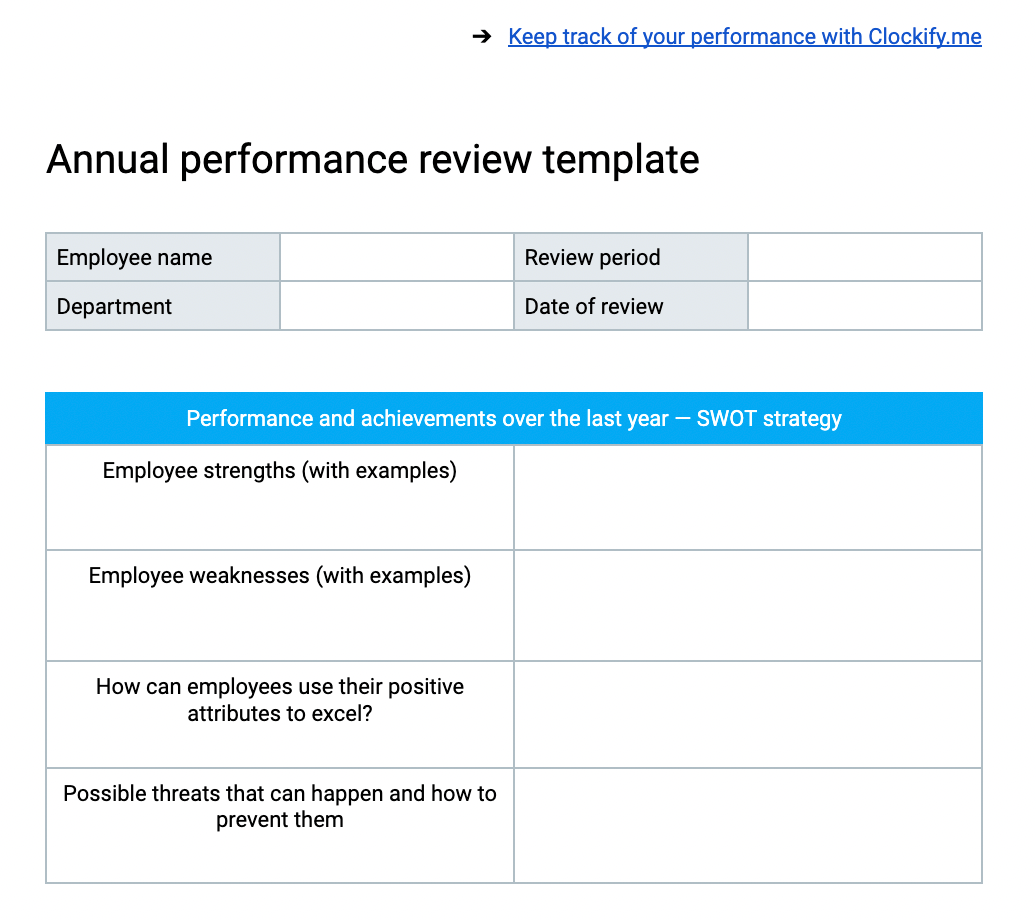
What's it about?
Our Annual performance review template analyzes employee performance over the last year.
The first part of the template follows the SWOT strategy (strengths, weaknesses, opportunities, and threats).
So, this is where managers fill out details about employee performance, including their positive and negative attributes.
Then, team leads can also suggest how employees should use their strengths to enhance their performance. Additionally, managers can include possible threats that may come along the way and ways to solve them.
Next, our Annual performance review template contains a section called Goal achievement. Thus, team leads can evaluate whether employees have reached set goals.
Finally, managers can also focus on making plans for the next year by discussing this topic with an employee. Team leads can talk to their employee about:
- Employee weak areas of performance
- Professional goals for the following year
Who is this template for?
The Annual performance review template is practical for all the managers who wish to reflect on the work of their employees over the past year.
Moreover, this template is invaluable because it allows team leads and employees to plan the next year together — by setting goals and figuring out if workers need help with reaching their targets.
Peer review template
GET Peer performance review template (Google Docs)
GET Peer performance review template (Word)
GET Peer performance review template (PDF)
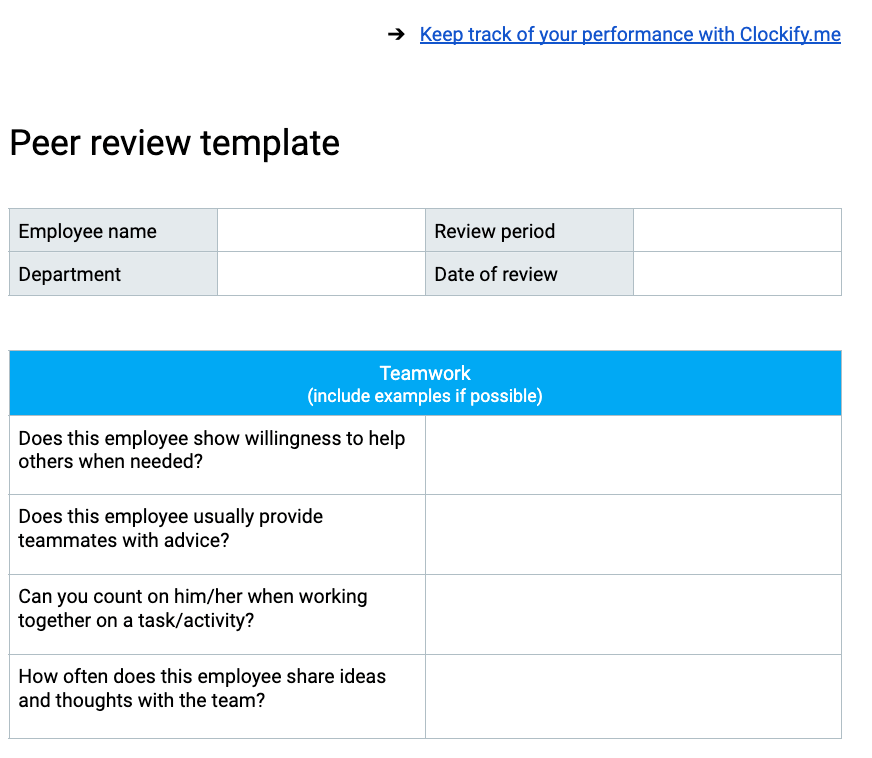
What's it about?
Our Peer review template allows managers to evaluate their workers objectively, by including peer opinions and ideas.
Thus, both coworkers and other team members review individual performance and provide their feedback.
To use this template properly, peers should review employee work by following these categories:
- Teamwork
- Collaboration and communication
- Trust and accountability
When answering questions in the appraisal, reviewers should also think about examples of someone’s work, and include them, too.
The final part of this template applies to team leads. They need to go through the appraisal and summarize key points, which they’ll later present to employees.
Who is this template for?
Our Peer review template is suitable for managers who’d like to include employee peers as reviewers — coworkers or other team members.
This type of review can be done anonymously or not, it’s up to the manager’s preferences. However, using anonymity is sometimes advised because it makes peers more comfortable to evaluate someone’s work fairly.
Self-assessment review template
GET Self-assessment review template (Google Docs)
GET Self-assessment review template (Word)
GET Self-assessment review template (PDF)

What's it about?
The Self-assessment review template helps employees evaluate their own work since the last appraisal, which might have been any other type of performance review.
To make the most of this template, employees should first think about their performance and achievements, and note down:
- Examples of good and bad performance
- The highlights of their work over the last appraisal period
- The obstacles that kept employees from reaching their targets
Next, employees should go through their job preferences and write down:
- The tasks they enjoy doing and the ones they don’t particularly enjoy
- The tasks they haven’t done so far, but would like to perform
Finally, employees need to plan their goals for the next appraisal period. If workers need any help from their managers or coworkers, they should write that down in the review, too.
Who is this template for?
Any employees who’d like to feel more included in the appraisal process and to express their own voice.
To provide employees with an opportunity to review their own performance, managers can include self-assessment reviews along with other appraisals. Therefore, both team leads and workers will evaluate employee performance.
Measure employee performance with Clockify
Apart from using our templates to review employee performance, you can also try Clockify to measure the performance of your workers.
With Clockify, employees can:
- Track the start time and end time of their daily work
- Write down task descriptions and record the time they need to complete each task
- Send reports of their work to their managers
Then, managers can use these reports to conduct employee performance appraisals.
For instance, Clockify provides users with the Weekly report, which helps team leads keep an eye on:
- What each employee is working on — their current projects, tasks, and the exact time spent on each project and task
- Weekly and daily breakdown by employee, with the total time spent at work each day

Furthermore, if managers want to see a report for an individual employee, they can use filters.
This way, a report will show data for a particular employee, along with their tracked hours and tasks over a period of time.

Once they have all the important data about an employee in one place, such as Clockify reports, managers can make decisions about:
- Employee attendance
- Employee productivity and efficiency
- Employee ability to achieve their goals
Thus, team leads will have a better clue of how employees are performing, by observing how much time they need for particular tasks. Therefore, it’ll be much easier for managers to conduct overall performance appraisals, too.
